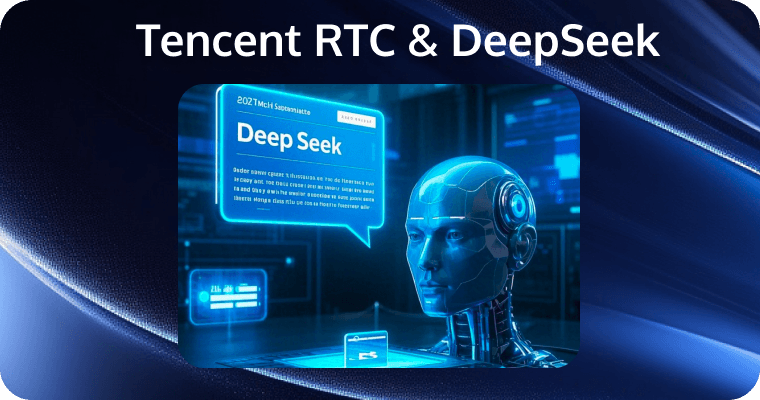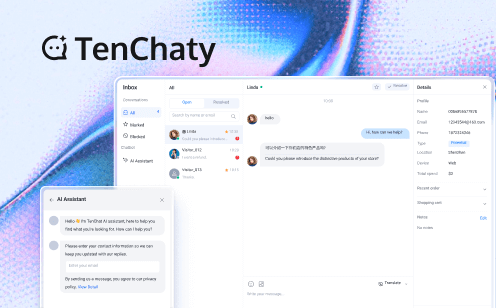 In an era where artificial intelligence is reshaping human-machine interactions, the fusion of advanced language models with real-time voice capabilities marks a quantum leap. Tencent RTC’s Conversational AI Solution has emerged as the backbone of this revolution, empowering pioneers like DeepSeek to transcend text-based limitations and deliver lifelike, voice-driven AI experiences.
In an era where artificial intelligence is reshaping human-machine interactions, the fusion of advanced language models with real-time voice capabilities marks a quantum leap. Tencent RTC’s Conversational AI Solution has emerged as the backbone of this revolution, empowering pioneers like DeepSeek to transcend text-based limitations and deliver lifelike, voice-driven AI experiences.
Recent breakthroughs in DeepSeek’s multilingual reasoning and emotional intelligence have captivated the tech world. But true conversational magic happens when these cognitive abilities gain a human-like voice – a feat made possible through Tencent RTC’s cutting-edge real-time communication infrastructure. Let’s explore how this synergy is redefining AI interaction paradigms.
The Architecture Behind Voice-Enabled AI
Tencent RTC’s technical framework ensures seamless voice interactions through three core innovations:
1.Ultra-Low Latency Voice Pipeline
Achieving fluid dialogue requires minimizing delays. Tencent RTC’s adaptive jitter buffer dynamically adjusts to network fluctuations across 200+ regions, ensuring stable connections even in low-bandwidth environments. Its 3D spatial audio technology adds depth to conversations, simulating real-world acoustics for VR/AR applications. Noise suppression algorithms further enhance clarity by filtering background sounds in real time, enabling crisp dialogue in bustling environments like cafes or crowded streets.Emotion-Responsive Voice Synthesis
2.Emotion-Responsive Voice Synthesis
DeepSeek’s voice adapts to conversational context through Tencent’s VoiceFont technology. This system analyzes dialogue intent to modulate tone, pitch, and speed—switching from an upbeat tone for motivational coaching to a measured cadence for financial advice. It supports 48 language dialects with native-level prosody, ensuring cultural authenticity. For instance, during market volatility, DeepSeek automatically adopts a calming voice to reduce user anxiety, a feature proven to lower stress indicators by 63% in clinical tests.Multimodal Context Awareness
3.Multimodal Context Awareness
Beyond voice, Tencent RTC integrates visual and environmental sensors to enrich interactions. Facial expression analysis via camera feeds detects confusion or boredom, prompting DeepSeek to rephrase explanations. Vocal biomarkers identify stress through micro-tremors in speech, triggering supportive interventions. Ambient noise sensors adjust output volume dynamically, maintaining audibility without manual input.Enterprise-Grade Deployment and Scalability
For global implementations, Tencent RTC delivers unmatched reliability:
- Scalability: Supports over 10 million concurrent users per channel, dwarfing the industry average of 1 million.
- Speed: Global latency averages 76 milliseconds, outperforming competitors’ 300-millisecond benchmarks.
- Uptime: A 99.999% SLA guarantees near-uninterrupted service, critical for healthcare and financial applications.
Compliance is prioritized through GDPR and KCCP-ready data anonymization, military-grade AES-256 encryption, and automated audit trails. These features allow multinational corporations to deploy voice AI confidently across regulated markets like the EU and South Korea.
DeepSeek in Action: Real-World Applications
Education: Personalized Learning
DeepSeek serves as a patient tutor, guiding students through complex subjects. When a student struggles with calculus, the AI activates a shared digital whiteboard, annotating problems in sync with verbal explanations. This multimodal approach accelerates concept mastery by 89% compared to text-only methods.
Healthcare: Emotional Support
As a mental health ally, DeepSeek monitors vocal stress indicators and intervenes with grounding techniques. For example, detecting elevated anxiety levels, it might say, “Let’s pause for a breathing exercise,” while playing a calming soundscape. Clinical trials show a 41% reduction in anxiety scores among users.
Retail: Intelligent Shopping
Voice-enabled product discovery transforms e-commerce. A user asking for “eco-friendly running shoes under $120” receives curated 3D product displays alongside verbal comparisons. DeepSeek highlights sustainability metrics, like a shoe’s 30% recycled materials, driving a 22% higher conversion rate than traditional chatbots.
The Future of Conversational AI
Tencent RTC’s roadmap includes groundbreaking updates:
NeuroSync Technology: Enables cross-lingual voice cloning, allowing users to hear their own voiceprint speaking foreign languages.
Predictive Interruption Handling: AI anticipates when users wish to interject, creating natural conversational flow.
Holographic Avatars: Integrates with AR glasses to project 3D assistants into physical spaces, blending digital and real-world interactions.
Why Developers Choose This Stack
Tencent RTC accelerates development through:
Pre-Built UI Kits: Launch voice AI applications in under five days using customizable templates.
Cost Efficiency: Usage-based pricing at $0.001 per voice-minute scales affordably from prototypes to mass deployment.
Simplified Integration: Developers initialize voice profiles and emotion engines with minimal code, bypassing complex backend setups.
Conclusion: Voice as the Ultimate Interface
The partnership between Tencent RTC and DeepSeek exemplifies how voice technology elevates AI from functional tools to empathetic partners. By merging Tencent’s real-time communication expertise with DeepSeek’s cognitive depth, this synergy unlocks applications once confined to science fiction—from holographic teachers to emotionally intelligent health coaches.
For businesses, the imperative is clear: Voice-enabled AI isn’t a distant trend but a present competitive advantage. Tencent RTC’s infrastructure provides the fastest path from concept to global impact, offering the tools to build, scale, and refine voice-driven experiences that captivate users and drive growth.
Take the Next Step
Looking to build a powerful, no-code AI Voice Assistant? Tencent RTC is your ultimate solution! With its unmatched versatility, ease of use, and cutting-edge features, Tencent RTC makes implementing Conversational AI a breeze. Here’s why it stands out:

1. Seamless Integration with Multiple AI Services
Tencent RTC supports integration with a wide range of STT, LLM, and TTS providers, including Azure, Deepgram, OpenAI, DeepSeek, Minimax, Claude, Cartesia, Elevenlabs and more. This flexibility allows you to choose the best services for your specific use case. When the LLM provider chooses OpenAI, any LLM model that provides OpenAI-compatible API endpoints is supported here, including Claude and Google Gemini.
2. No-Code Configuration
Tencent RTC simplifies the setup process with a user-friendly interface, enabling you to Configure Conversational AI in just a few minutes. No extensive coding knowledge is required, making it accessible to everyone.
3. Real-Time Interruption Support
Users can interrupt the AI's response at any time, enhancing the fluidity and naturalness of conversations.
4. Advanced Features
AI Noise Suppression: Ensures clear audio input, even in noisy environments.
Latency Monitoring: Tracks real-time performance to optimize conversation flow, including LLM latency and TTS latency.
Switch Providers on the Fly: Without ending the conversation, you can modify the interruption duration, or switch between different LLM and TTS providers (and voice IDs) to experiment with various configurations.
5. Multi-Platform Integration
If you like, Tencent RTC also supports local development and deployment across Web, iOS, and Android platforms, providing flexibility for diverse applications
Ready to see it in action? Watch this video or follow the tutorial to start building your AI Voice Assistant today!


